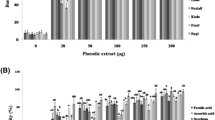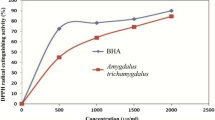Abstract
Lipid peroxidation by ROS at the membrane level disturbs the inherit integrity of components activating subsequent alterations in the function. In this study, the protective effect of purified Sundakai (Solanum torvum) seed protein (SP) was tested against oxidative membrane damage in erythrocyte membrane. SP prevented oxidative RBC lysis induced by pro-oxidants; Fe:As (2:20 μmol), periodate (0.4 mM), and t-BOOH (1 mM) up to 86, 81, and 86 %, respectively. Further, SP prevented the Fe:As-induced K+ leakage up to the tune of 95 %. The inhibition offered by SP on K+ leakage was comparable to inhibition offered by quinine sulfate, a known K+ channel blocker. SP dose dependently restored Na+K+ ATPase and Ca2+Mg2+ ATPase activities in erythrocyte membrane. The restoration of ATPase activity by SP was two times more than standard antioxidants BHA and α-tocopherol. Besides, SP at 1.6 μmol restored the membrane proteins over Fe:As induction when analyzed by SDS-PAGE, which was comparable to protection offered by BHA. In conclusion, SP is an effective antioxidant in preventing oxidative membrane damage and associated functions mediated by ROS. As SP is non-toxic, it can be used as an effective bioprotective antioxidant agent to cellular components.







Similar content being viewed by others
Abbreviations
- BHA:
-
Butylated hydroxyanisole
- Fe:As:
-
Ferrous sulfate:ascorbic acid
- t-BOOH:
-
Tertiary butyl hydroperoxide
- TBA:
-
Thiobarbituric acid
- TBARs:
-
Thiobarbituric acid reactive substances
- MDA:
-
Malondialdehyde
- °C:
-
Degree Celsius
- H:
-
Hour(s)
- Mg:
-
Milligram
- Μg:
-
Microgram
- μM:
-
Micromolar
- nm:
-
Nanometer
- %:
-
Percentage
- SD:
-
Standard deviation
References
Allegra M, Gentile C, Tesoriere L, Livers M (2002) Protective effect of melatonin against cytotoxic actions of malondialdehyde: an invitro study on human erythrocytes. J Pineal Res 32:187–193
Ames BN (1966) Assay of inorganic phosphate, total phosphate and phosphatases. In: Neufeld E, Ginsburg V (eds) Methods in enzymology Vol. VIII: complex carbohydrates. Academic Press, New York, pp 115–118
Aviram M (2000) Review of human studies on oxidative damage and antioxidant protection related to cardiovascular diseases. Free Radic Res 33:S85–S97
Bradford Marion M (1976) A rapid and sensitive method for the quantitation of microgram quantities of protein utilizing the principle of protein—dye binding. Anal Biochem 72:248–254
Butterfield DA, Koppal T, Howard B, Subramanium R, Hall N, Hensley K, Yatin S, Allen K, Aksenov M, Aksenov M, Carney J (1998) Structural and functional changes in proteins induced by free radical-mediated oxidative stress and protective action of the antioxidants N-tert-butyl-alpha-phenylnitrone and vitamin E. Ann N Y Acad Sci 854:448–462
Celedon G, Gonzalez G, Pino J, Lissi EA (2007) Peroxynitrite oxidizes erythrocyte membrane band 3 protein and diminishes its anion transport capacity. Free Radic Res 41(3):316–323
Dodge JT, Mitchell C, Hanahan DJ (1963) The preparation and chemical characteristics of hemoglobin free ghosts of human erythrocytes. Arch Biochem Biophys 100:119–128
Esterbauer H, Schaur RJ, Zollner H (1991) Chemistry and biochemistry of 4-hydroxynonenal, malonaldehyde and related aldehydes. Free Radic Biol Med 11:81–128
Fraga CG, Tappel AL, Lebovitz BE, Kuypers F, Chiu D, Lacono JM, Kelly DS (1990) Lability of red blood cell membranes to lipid peroxidation: application to human fed polyunsaturated lipids. Lipids 25:111–114
Halliwell B (1994) Free radicals, antioxidants, and human diseases: curiosity, cause, or consequences? Lancet 334:721–724
Halliwell B, Gutteridge JMC (1989) Free radicals in biology and medicine, 2nd edn. Clarendon press, Oxford
Halliwell B, Gutteridge JMC (1999) Free Radicals in Biology and Medicine, 3rd edn. Oxford University Press, Oxford
Hexum TD, Fried R (1979) Effects of superoxide radicals on transport (Na+K+) adenosine transport triphosphatase and protection by superoxide dismutase. Neurochem Res 4:73–82
Kaul S, Krishnakanth TP (1994) Effect of retinol deficiency and curcumin or turmeric feeding on brain Na+K+ adenosine transport triphosphatase activity. Mol Cell Biochem 137:101–107
Kris-Etherton PM, Lichtenstein AH, Howard BV, Steinberg D, Wiztum JL (2004) Nutrition Committee of the American Heart Association Council on Nutrition, Physical Activity and Metabolism. Antioxidant vitamin supplements and cardiovascular diseases. Circulation 110:637–641
Laemmli UK (1970) Cleavage of structural proteins during the assembly of head of bacteriophage T4. Nature 227:680–685
Lee HC, Wei YH (2007) Oxidative stress, mitochondrial DNA mutation, and apoptosis in aging. Exp Biol Med (Maywood) 232:592–606
Marappan S, Leela S (2007) Isolation and purification of a novel antioxidant protein from the water extract of Sundakai (Solanum torvum) seeds. Food Chem 104:510–517
Moore BR, Brummitt IM, Mankad NV (1989) Hydroperoxides selectively inhibit human erythrocyte membrane enzymes. Arch Biochem Biophys 273:527–534
Pacifici RE, Davies KJ (1990) Protein degradation as an index of oxidative stress. Methods Enzymol 186:485–502
Phrueksanan W, Yibchok-anun S, Adisakwattana S (2014) Protection of clitoria ternatea flower petal extract against free radical-induced hemolysis and oxidative damage in canine erythrocytes. Res Vet Sci 97:357–363
Rajamani K, Renju VC, Sethupathy S, Soasundaram S, Thirugnanasambandan S (2014) Ameliorative effect of polyphenols from Padina boergesenii against ferric nitrilotriacetate induced renal oxidative damage: with inhibition of oxidative hemolysis and in vitro free radicals. Environ Toxicol 30:865–876
Riccioni G, Mancini B, Di IIio E, Bucciarelli T, D`Orazio T (2008) Protective effect of lycopene in cardiovascular disease. Eur Rev Med Pharmacol Sci 12:183–190
Rohn TT, Nelson LK, Waeg G, Quinn MT (1998) U-101033E (2,4-diaminopyrrolopyrimidine), a potent inhibitor of membrane lipid peroxidation as assessed by the production of 4-hydroxynonenal, malondialdehyde, and 4-hydroxynonenal-protein adducts. Biochem Pharmacol 56:1371–1379
Sies H (1997) Oxidative stress: oxidants and antioxidants. Exp Physiol 82:291–295
Tappel AL (1973) Lipid peroxidation damage to cell components. Fed Proc 32:1870–1874
Tesoriere LD, Arpa D, Conti S, Giaccone V, Pintaudi AM, Livrea MA (1999) Melatonin protects human red blood cells from oxidative hemolysis: new insights into the radical-scavenging activity. J Pineal Res 27:95–105
Tulipani S, Alvarez-Suarez JM, Busco F, Bompadre S, Quiles JL, Mezzetti B, Battino M (2011) Strawberry consumption improves plasma antioxidant status and erythrocyte resistance to oxidative haemolysis in humans. Food Chem 128(1):180–186
Tulipani S, Armeni T, Giampieri F, Alvarez-Suarez JM, Gonzalez-Paramas AM, Santos-Bluelga C, Busco F, Principato G, Bompadre S, Quiles JL, Mezzetti B, Battino M (2014) Strawberry intake increases blood fluid, erythrocyte and mononuclear cell defenses against oxidative challenge. Food Chem 156:87–93
Van den Berg JJ, Op den Kamp JA, Lubin BH, Roelofsen B, Kuypers FA (1992) Kinetics and site specificity of hydroperoxide-induced oxidative damage in red blood cells. Free Radic Biol Med 12(6):487–498
Widen C, Ekholm A, Coleman MD, Renvert S, Rumpunen K (2012) Erythrocyte antioxidant protection of rose hips (Rosa spp.). Oxidative Cell Longev 2012:1–8
Zhu QY, Hackman RM, Ensunsa JL, Holt RR, Koeen CL (2002) Antioxidative activities of oolong tea. J Agric Food Chem 50:6929–6934
Acknowledgments
The authors acknowledge the Adichunchanagiri Shikshana Trust and The principal, Adichunchanagiri Institute of Medical Sciences (AIMS), B.G.Nagar for providing facilities to carry out this work.
Author information
Authors and Affiliations
Corresponding author
Rights and permissions
About this article
Cite this article
Sivapriya, M., Gowda, S.S.T. & Srinivas, L. Protective Effect of Sundakai (Solanum torvum) Seed Protein (SP) Against Oxidative Membrane Damage in Human Erythrocytes. J Membrane Biol 248, 1137–1144 (2015). https://doi.org/10.1007/s00232-015-9831-8
Received:
Accepted:
Published:
Issue Date:
DOI: https://doi.org/10.1007/s00232-015-9831-8




